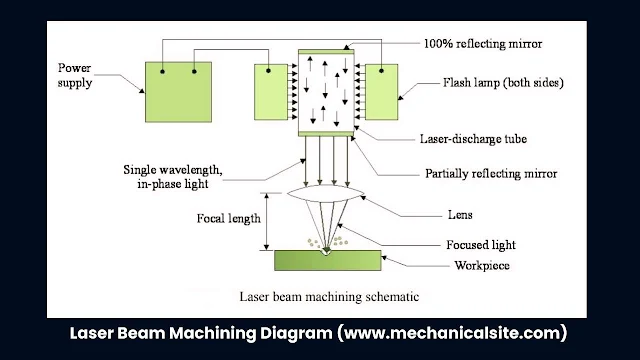Laser Beam Machining: Working Principle, Types, Advantages, Applications & Key Process
Laser Beam Machining: Understanding This High Precision Machining Technique
Laser beam machining (LBM) utilizes a concentrated laser beam to selectively remove material and machine parts with extremely high precision. This non-contact machining technique has become popular for micromachining applications across industries.
How Does Laser Beam Machining Work?
- A high power laser like CO2, Nd:YAG, excimer or fiber laser generates an intense beam of coherent light.
- The laser beam gets focused to a very fine spot size, typically between 0.1 mm to 0.3 mm diameter, using optical lenses.
- The workpiece is irradiated by the focused beam which gets absorbed and rapidly heats, melts and vaporizes the material in a controlled way.
- No cutting tools or contact forces are involved. The laser head or workpiece moves under CNC control to cut patterns.
- Precise laser cutting, drilling, marking and other machining is done by selectively ablating material.
What are the Advantages of Laser Beam Machining?
- Extremely high machining accuracy down to ±0.025 mm and fine resolution from the tight laser beam focus.
- Ability to precision machine hard, brittle materials like ceramics, carbides, diamond.
- No tool contact leads to no material deformation during the non-contact machining process.
- Excellent cut surface finish without burrs, cracks or heat affected zone.
- Flexible process capable of cutting complex 2D and 3D shapes.
Applications of Laser Beam Machining
- Drilling cooling holes in turbine blades and nozzles for the aerospace industry.
- Cutting and scribing of intricate shapes in automotive and electronics components.
- Marking logos, engraving designs on precision parts for medical devices.
- Structuring, cutting, drilling glass, ceramics and other brittle materials.
- Machining extremely hard materials like ceramics, carbides, diamond, etc.
Types of Laser Beam Machining Processes
- Laser cutting - material removal by traversing focused laser for cutting patterns.
- Laser drilling - producing deep holes by evaporating material with the laser beam.
- Laser marking - controlling beam to mark or color surfaces without cutting through.
- Laser engraving - using laser ablation to engrave patterns, designs on workpieces.
Key Process Parameters
Critical laser beam machining process parameters:
- Laser power, pulse energy, repetition rate
- Focusing lens type, focal spot size
- Beam interaction time with material
- Wavelength of laser beam
- Workpiece material properties
- Precision CNC motion control
Material Removal Mechanism
The high energy density laser beam is focused on a very small area, rapidly heating it to melt and vaporize material by intense localized heating. The vaporized material is removed by pressurized assist gas, allowing precision material removal without contact forces.
FAQ About Laser Beam Machining
What is the typical wavelength of a ruby laser used in laser beam machining?
Ruby lasers used in laser machining have a wavelength of 694 nm, which falls in the visible red spectrum.
What depth can laser beam machining cut?
Laser cutting depth depends on the material but typically lasers can cut up to 25 mm in mild steel. Multiple passes allow deeper cuts.
Is heat affected zone a problem in laser beam machining?
Minimal heat affected zone exists during laser machining. Optimizing process parameters like power, speed minimizes the thermal effects.
In summary, laser beam machining is an advanced non-traditional machining process offering high accuracy and precision while being able to machine extremely hard and brittle materials for production applications.







